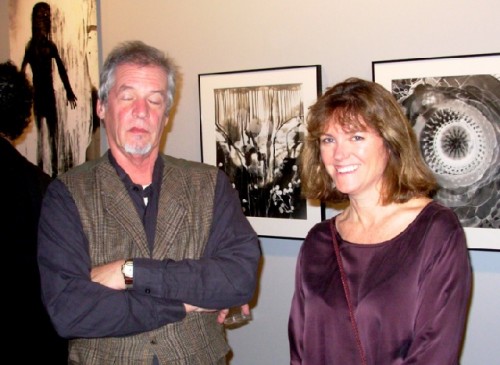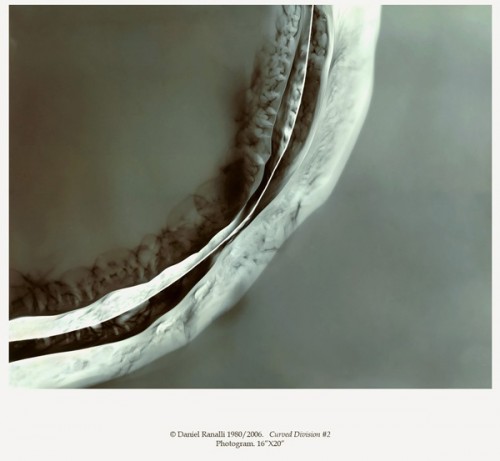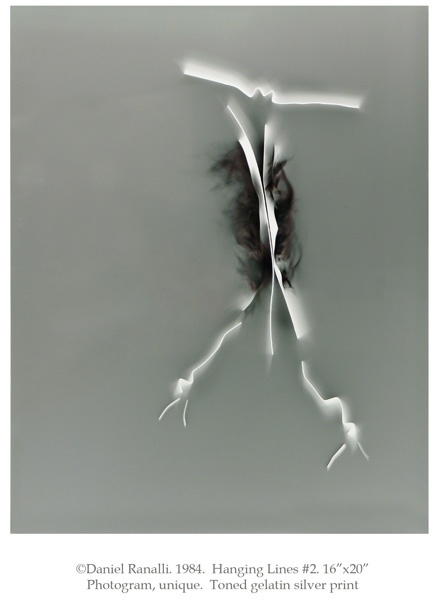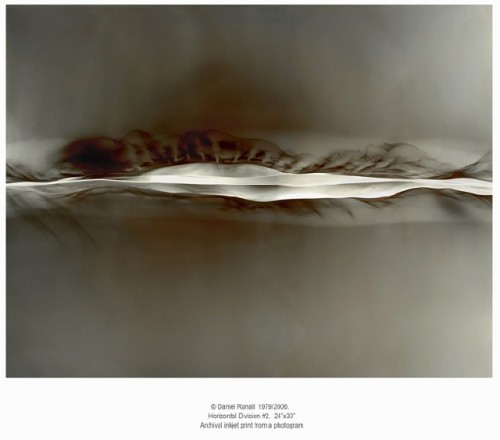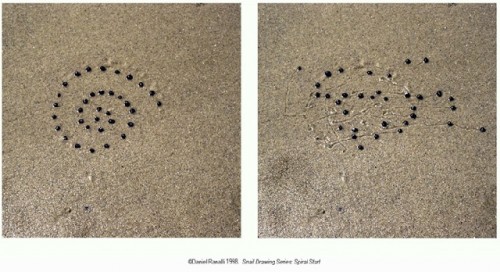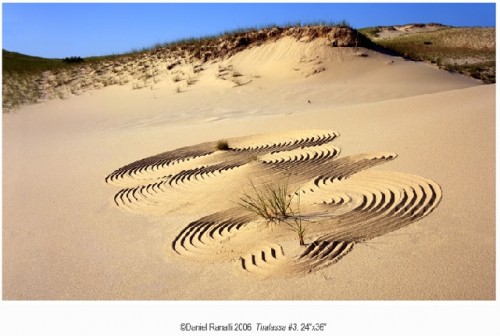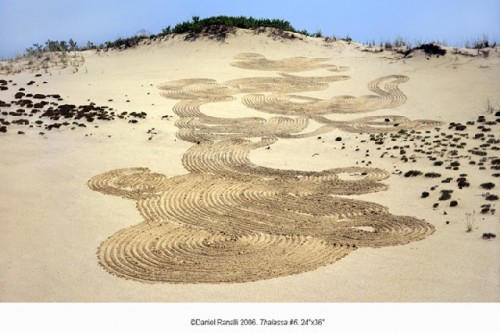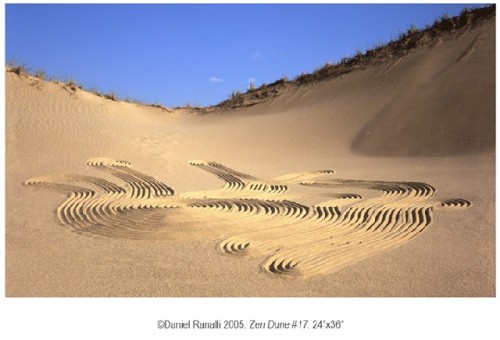Photographer Daniel Ranalli: Beer and Burger
Artist, Writer, and Director of BU's Arts Administration Program
By: Charles Giuliano - Dec 02, 2006
Over the past decades our paths have crossed on many levels. We were columnists for Art New England. Daniel Ranalli wrote Forum from the point of view of an artist about institutions and issues while I wrote Perspective that provided an overview of the art world including interviews with most of the regional museum directors of that era. We often compared notes about the vagaries of the publication and a mutual antipathy toward a former editor. Mostly we agreed on our sharp critiques of local institutions including the perennial pratfalls of the Institute of Contemporary Art. Dan was often sought out by Globe reporters for comments related to arts developments.
For many years I have reported to him as an adjunct professor at Boston University where he chairs the Arts Administration graduate program for Metropolitan College. He has also had a career as an exhibiting artist including "Pictures Outside the Box" which has just opened at Gallery Kayafas in Boston's South End. During summers Dan and his artist wife Tabitha Vevers are active in the arts community of Provincetown. For a time our interests overlapped when I was pursuing a history of that legacy.
With so much commonality it is surprising that it was the first time that we talked head to head over a beer and burger. It proved to be a lively dialogue that clarified some misconceptions. He said "I was wondering when you would get around to me?" But it was such fun, even though he hastily departed but still got a parking ticket, that we want to meet again soon. He is back at BU after a year's sabbatical that proved to be a mixed experience. There had been ambitions for three separate trips abroad that got reduced to just one. During this time his father was ill and eventually passed away. But the break from teaching allowed for the precious time to be with him.
Tabitha was a fellow at Ballinglen http://www.ballinglenartsfoundation.org/ an artist residence program in Bally Castle, Ireland that a number of Boston area artists have participated in. He got to tag along and because someone didn't show up even managed to get a small studio where he pursued his own work. "I'm doing some of the best work of my life," he said. As the early work in the Kayafas show demonstrates he was initially fascinated by photograms a technique of using objects directly on paper that do not involve the use of a camera. In many ways he is still a formalist and even discusses using the dark room to make prints. But these are then scanned and worked digitally.
Because of the environment of the Lower Cape nature, particularly the seashore and dunes, have become a content for the often conceptual work including Zen like raked patterns in the sand, or the migrations of snails in before and after configurations. A few years ago Dan and Tabitha had access to one of the legendary Dune Shacks where artists may live embedded in nature with few of the amenities familiar to urban dwellers. It is where you sense they really want to be; at peace with nature and doing their creative work. Significantly, Tabitha's works involve painting whimsical allegorical vignettes in sea shells. Looking at the six oysters in front of me I quipped that they could well represent her next one person show.
But for all the reveries of nature one has to earn a living. Hence the complex and demanding life as a teacher, administrator, writer, observer, raconteur and combatant in the perennial battles of the art world. "My first identity is as an artist and everything else I do, writing and teaching, is secondary to that."
The commitment to the Lower Cape is important and recently he and some artists founded artStrand http://artstrand.com/ a group gallery. "We represent eleven mid career artists and the split is six to five between male and female. The artists all represent a long term connection to the Cape community. Some of the artists include Jim Peters who is a very good painter. He is known for nudes of his wife Vicki. Also Paul Bowen (who has recently left the Cape), Tabitha, Anna Poor, Bob Bailey,Jay Critchley,Breon Dunigan, Maryalice Johnston, Irene Lipton and Bert Yarborough."
If being an artist is such a strong identity getting there wasn't easy. He grew up as a townie in New Haven the son of working class parents. Asked about it Dan says that he could strongly identify with the Matt Damon character in "Good Will Hunting." With so much Town and Gown conflict as a teenager he says with irony that he was surprised eventually to marry a "Yalie" (Tabitha). Despite a high IQ he did not perform well in high school. Not having impressive grades he matriculated to New Haven College where he ended up with a 4.0 average at the end of freshman year. It was during this time that he was able to focus and turn it around. This led to transferring to Clark University in Worcester from which he graduated with a degree in Economics in 1968. Those were protest years and he describes himself a member of SDS (the radical group Students for a Democratic Society). Clark proved to be a stimulating and eccentric campus. Robert Hutchins Goddard (1882-1945) was an assistant processor at Clark in 1915 when he began to develop rockets. Sigmund Freud lectured at Clark as did Carl Jung.
"Part of what got me into Clark was that by then I had produced an 8 MM film," he said. "Clark was an alternative school like Hampshire College. It changed my life. From there I went on to graduate school in Economics at Boston University. It was the Vietnam era and campuses were political. I had discovered art in college but being the first in my family to get to college there was no way I could major in art. But in 1971 I took all the papers involved in my research for a Ph.D. in Economics and went out to the back yard and set them on fire. I guess you might say it was my first conceptual art piece. I had by then participated in workshops with Minor White who was teaching at MIT. You had to be an MIT student to study with him in his program but he did workshops outside the university."
The impact of Minor White on the Boston-Cambridge community and his complex, contentious relationship with MIT, including the current state of the archive and his legacy, is an important and complex topic. The program he started was never really accepted within the mainframe of MIT and it continued briefly but was abandoned after his death. White had an enormous impact on Ranalli and others who studied with this great master of photography.
Because of White's strong influence I asked Dan if he is a formalist? "I think so," he replied. "It is a tendency and a vocabulary that appeals to me. I still have a dark room. This winter I made prints and scanned them. And I went back to making photograms. I had enjoyed a lot of success with them in the 70s and 80s. I got two NEA grants and two Mass Council grants in the late 80s and I sold work to twenty museums. I applied to Rhode Island School of Design for their MFA program but they said you already have an MA (in Economics) so you would be better to spend the time and money just doing your own work."
Part of that interest in RISD was seeking confirmation as an artist. If you pursue an MFA this contributes to the notion that one is an artist. "Am I an artist," he asked rhetorically? "There is a lot of doubt and no official signifier. It's my life based on a decision I made 35 years ago." He extends that self criticism to state that "I'm a fallen writer. In the mid 80s I began to write for Art New England. I wanted my work (photography) to have a narrative sensibility. There was text in the photos as well. I wanted the writing to have a social and political context. For twelve years, 1983-1994, I wrote Forum for Art New England."
During that time when we were colleagues and ANE columnists there was a running gag as to who pissed off more people. We continue to feel that there is not a sharp enough critical dialogue in the arts community, now more than ever, as we have entered an era of careerism and opportunism. For many of our generation the great question was just being an artist or having a life in the arts, not climbing the ladder of status and celebrity. Today, many younger curators and museum directors will not consider any moves that are not related to their next job. Artists cranked out of schools with freshly minted MFAs pack it in if they don't make it big in the next five years. We never really thought about that. The real issue was just to survive and make the work. Still is.
For Dan much of his controversy involved a relentless critique of the Institute of Contemporary Art, its self absorbed programming, and lack of a relationship to the local community of artists. It prompted Dan to repeat a familiar statement. "The ICA could do an exhibition of all the Boston artists it has ever shown. Put the names on a standard post card announcement and still have room for a commemorative Elvis stamp." Significantly, the ICA is currently showing four, separate one woman shows for the finalists in a biannual ICA artist's award. During the era of former director, David Ross, there was a series of annual Boston Now shows but that was abandoned by Milena Kalinovska and not revived under the current director, Jill Medvedow. Now that it occupies a building with three times the exhibition space of its former home it remains to be seen just how the Boston community of artists relate to the new ICA. It is a tropic that I have invited Dan to think and write about for this site. Another former ANE columnist and colleague, Mark Favermann, is preparing a report for us on the architecture of the new ICA.
With the exception of the DeCordova, and we share ambivalence about that institution which is seeking to replace its long term director, Paul Master Karnik, Dan asked rhetorically just what institutions have made a commitment to encouraging the careers of Boston artists? The Museum of Fine Arts has the annual Maud Morgan Prize for a woman artist but that's mostly just a bit of window dressing. Under Malcolm Rogers the MFA circled the wagons a long time ago.
But for a time through the pages of ANE we shared a vision and fought the good fight. He quit when he felt the publication was going down hill. It was on the block and the publishers were losing interest. I hung in only to get sacked when new owners cleaned house. Frankly, I lost interest and don't even look at the rag any more although a new editor is promising changes. Let's hope so.
About the same time that Dan abandoned his column he describes personal issues including divorce. There are regrets "I loved my column and miss that soap box." But he was in the process of reinventing himself as an arts administrator and eventually setting up programs to teach this new field.
"My first job in the field of arts administration was for the old Massachusetts Arts and Humanities Foundation," he said. "I ran the artist in residence program. It was a way of administering money from the National Endowment for the Arts and state money to fund artists. It was a program in all 50 states and I ran it in Massachusetts in the mid 1970s. I called myself an 'artocrat.' We didn't even have the term 'arts administrator' back then. I just fell into doing that work for a dozen years."
He discussed a major change in the field in recent years. The paradigm was for museum directors to hold a Ph.D. in art history. Nothing in that training involved the business complexities and knowing how to manage a spread sheet. That changed when museum director like David Ross, at the ICA and later the Whitney, or Kathy Halbreich first at MIT and currently at the Walker Art Center, never went further than a B.A. but had savvy and hands on experience. The new paradigm is represented by Tom Krens of the Guggenheim who holds both M.F.A and M.B.A degrees. In order to get a college level teaching position one still has to pursue a Ph.D. in art history. But in the museum field an M.A. in arts administration is becoming an ever more viable option. It just wasn't on the table when I was a graduate student at Boston University ending up with an M.A and A.B.D.
In 1984, Dan applied for the position of directing an arts administration program for Leslie College which he pursued "with little support" for the next six years. Under the skeptical watch of former BU president, John Silber, he offered to bring his program to BU. He started with a two year contract and a pre nuptial agreement that it would terminate if he was not successful in recruiting 20 students. He states that it is the most successful program of its kind with 90 students currently enrolled, half in the performing arts and half in the visual arts. With a twinkle he stated that "Our motto is that we are making the world safe for art."
He describes it as a rigorous program that costs $28,000. The courses are offered in the evening and students typically take two classes a semester and have full time day jobs. There are 16 professors offering a range of business, law and arts courses. All of them are professionals in the fields that they teach. Of the graduates of the program some 85% work in their field of study. Out of some 250-300 students not more than a dozen have failed to complete the program. The profile of an average student is female, 26 years of age, from top schools all over the country, with undergraduate majors in music, the performing arts, and art history.
A critique is that one might acquire those skills just by working in the field as Dan himself did. But with an emphasis on credentials today the degree allows for getting that entry level position and leverage to jump start a career. But it is a lot of work, expense and commitment for a field in which starting positions, with an M.A. degree, are in the range of $35,000 to $40,000. But it provides a door opener for a life in the arts. Something that guys like Dan and I never had when we were starting out and trying to convince our families that we wanted to be artists. All these years later we still have our doubts. Good heavens.


